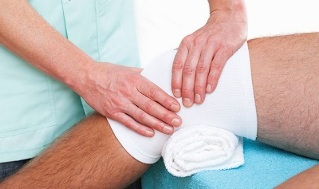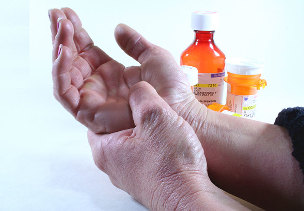The most common joint pathologies are arthritis and arthrosis. The two diseases have many differences, depending on the outcome of the disease. Proper definition of the disease by a physician is the key to effective treatment for the full recovery of the affected joint. Under the influence of age-related changes, everyone is at risk of pathological changes in the joints. Joints are particularly affected, which experience increased lifelong stress. Disease can be a direct cause of joint changes. To prevent the undesirable consequences of joint disease, it is necessary to prevent the disease from developing, adhere to preventive measures and treatment.
The main difference between arthritis and arthrosis
Joint pathology: arthritis and arthrosis have a negative impact on the quality of life of patients. The causative process of disease in the joints causes pain and limited mobility. Both of these diseases lead to destructive changes in the articular structure, but differ in terms of the origin and course of the disease.
Arthritis, if we compare it to arthrosis, is a pathology of acute or chronic arthritis, which can appear with autoimmune infections or diseases, become post-injury complications, and even occur with allergic reactions.

Single and multiple joints are affected. In addition, the inflammatory process spreads throughout the body, involving internal organs in the process.
Osteoarthritis is a process of cartilage modification, which causes joint damage to the point of complete loss of movement, such as arthritis. Pathological processes develop in view of age-related changes in joint tissues, exacerbated by patient overweight, metabolic disorders and endocrine system pathology.
The causes of arthritis and arthrosis differ significantly. The only unifying factor is the similarity of some of the symptoms and unpleasant outcomes of the untreated form.
Arthritis Triggers:
- development of inflammation of the knee articular tissue after various types of trauma;
- infection of the knee joint etiology of viruses, fungi and bacteria;
- severe allergies;
- prolonged exposure to cold air;
- vitamin and mineral deficiency;
- hereditary tendencies.
The onset of arthrosis differs from arthritis in the state of inevitable changes in each person of age. Knowing the etiology of the disease, even at a young age, it is possible to adjust diet and lifestyle to prevent pathology.
Development occurs in the following situations:
- the use of joint components is due to aging;
- weight gain significantly increases daily load on the knee;
- deformity disorders due to injury;
- malnutrition;
- arthrosis can be a complication of arthritis, or more precisely inflammation, found in the disease;
- autoimmune pathology of unexplained etiology;
- congenital pathology associated with joints;
- violations of trophism and blood supply to the joints;
- thyroid gland damage;
- changes in hormone levels;
- polluted environment.
Difference Features
These two diseases are similar but different in different ways. Among the young population, aged up to forty years, arthritis is more common, and the process of cartilage tissue damage affects the elderly, and the older the person, the higher the risk of the disease.
Arthrosis is a disease that is localized mainly to the joints, without spreading to the surrounding organs and tissues. Arthritis can be one of the more serious manifestations of the disease involving the whole body in the inflammatory process. Both of these diseases can occur in acute and chronic forms, only arthrosis develops for a longer period of time and can cause complete joint damage.
Arthritis has brighter symptoms, accompanied by external manifestations that are characteristic of inflammation: hyperemia in the area of localization of the process, significant swelling, hot skin in the affected joint area, pain syndrome. Arthrosis runs more smoothly, without spreading outside the joint.
Arthritis, in contrast to arthrosis, most often involves small joints in the process: joints of the hands, feet, wrists and ankles. The disease is rare in one joint, polyarthritis is a more common form, and arthrosis is localized in large joints.
According to statistics, middle-aged men are more likely to develop articular pathology than infections and viruses. The process of joint damage is most common in the female population during menopause, especially after the fifty-year mark. Children can also be prone to joint damage, especially juvenile arthritis is considered dangerous, which can lead to restrictions.
Signs of manifestation
It is important to seek medical advice at the first symptom in order to successfully heal and restore joints for optimal motor activity. Arthritis and arthrosis differ significantly in the early stages of the disease. Inflammation is indicated by the severity of the symptoms, which is easy not to miss the onset process.
Distrophic changes in joint tissue are less indicated at an early stage, so patients often come to the orthopedist when the disease is in the second or third stage of development. In this case, the treatment is complicated, takes a long time and requires many steps to restore normal joint function. The slow process is difficult to diagnose on its own, but for any manifestation of discomfort in the joints, you just need to go to the doctor's office so as not to miss the early stages of the disease.
How does arthritis manifest itself?
- Unlike arthrosis, with arthritis, swelling appears around the inflamed joints, impeding movement and causing a lot of difficulty when moving freely.
- In acute inflammation, the skin on the joints becomes bright and hot hyperemic when touched.
- If arthritis is the type caused by infection. The general condition of the patient suffers, intoxication begins, which is accompanied by a state of fever.
- Piercing pain appears in inflamed joints, which tend to increase significantly with movement. In a calm state, the pain syndrome does not subside, but becomes pulsating.
- In most cases, arthritis is accompanied by worsening conditions, weakness appears, and chronic illness worsens.
- The most vulnerable are the joints of the fingers and toes, as well as the ankles and hands.
Symptoms of Arthrosis
Manifestations of arthrosis have no characteristic signs in the first years of the disease, the use of joints makes itself felt after several stages of development of pathological conditions.
Signs of arthrosis:
- pain does not appear immediately, pain increases as joint condition worsens;
- in the absence of movement, pain does not arise, pain syndrome begins to develop after activation;
- in case of damage to the hip or knee joint - the gait drowns, and the distance of movement is incomplete;
- in neglected conditions, shortening of the lower limbs may occur, if there is no correction, pathology in the spine develops;
- when cartilage tissue is destroyed, joints lose movement and joint blockage completely occurs;
- mentions creepitus in the joints during physical activity.
How to treat a disease?

Arthritis and arthrosis differ significantly in treatment approaches. The various causes and mechanisms of pathological development indicate the correct initial setting of the diagnosis until the therapeutic measures are effective.
In order not to start the disease and waste valuable time, do not rely on the experience of friends and folk recipes.
The disease process that has a detrimental effect on the joints should not be allowed to run smoothly. It is important to feel the joy of movement at any age; not only well-being, but also the quality of one's life depends on it.
Treating arthritis
Treatment should be started by identifying the causative factor of inflammation. After determining the original nature of the disease, drugs are prescribed that destroy the pathological disease. When exposed to pathogenic bacteria, patients are given antibiotics, which depend on the degree of toxicity, prescribed in the form of tablets or injections. Viral lesions are treated with antiviral pills.
The basis of effective elimination of inflammation and pain suppression is the mandatory intake of non-steroidal anti-inflammatory drugs. They will help overcome unwanted symptoms, both when taking pills and local effects on joint pain areas.
Strengthening the immune system is the foundation for successful disease control. Taking a multivitamin with micronutrients will support a weak body and help change the course of the disease towards recovery. In addition to synthetic complexes, natural sources of vitamins are also useful - berries, fruits, vegetables.
Adequate nutrition and special diet are indicated for patients with arthritis, as well as with arthrosis. Allowed products include fermented dairy products, lean meats, fish, vegetables, ingredients. You should avoid strong coffee and black tea, carbonated drinks and alcohol.
Physiotherapy and physiotherapy procedures give excellent results in combination with primary therapy: treatment with magnetic pulsed fields, radon baths, electrophoresis and other methods. The list of special exercises is compiled by the physiotherapist, under whose supervision the load is performed.
We treat arthrosis
The disease progresses slowly and has fundamentally different treatments, which should be aimed at restoring joint cartilage tissue. The real safety is the use of chondroprotectors, which, with prolonged use and following a doctor's recommendation, can prevent the development of destructive changes and restore damaged cells.
Chondroprotectors support tissue nutrition and promote cartilage repair, as well as increase joint fluid production, which serves as the only source of nutrients for joint components.
When pain occurs, NSAIDs are recommended to treat pain symptomatically. Enriched diet, quitting drinking alcohol and smoking lead to increased endurance and increased strength to fight for healthy joints.
Therapeutic gymnastics uses a variety of methods to improve blood circulation at the site of injury, make the joints move, increase trophism. Traditional recipes, tested for many years, are useful as an additional method of alternative medicine.
In the final stages of arthrosis and arthritis, the only solution is surgical treatment of joint capsules. The most commonly used method is cartilage transfer, which can restore movement to the affected joint.
How to diagnose a disease?
To find out exactly what diseases arise in the joints, you need to make an appointment with an experienced orthopedist. At the first meeting, the doctor will do a visual examination and ask interesting questions that will help shape the picture of the disease.
Laboratory blood test results will help differentiate arthritis from arthrosis, this requires general and biochemical tests. X-ray examination will help to examine the joints in detail from the inside.
In some pathologies, the patient is referred for magnetic resonance examination, which will answer the doctor's question about the pathological diagnosis. After collecting all the results, a diagnosis will be made, which will be the basis for prescribing treatment.
Precautions
Maintaining joint health requires a healthy lifestyle. Proper nutrition and regular exercise will prolong the life of the joints, which is important for overall health.
At the slightest manifestation of arthrosis or arthritis, you should not treat it. Improper action can have a negative impact on the outcome of the disease. Timely referral to a specialist and further adherence to the promise of successful treatment, which makes it possible to lead a healthy lifestyle.





































